BY TERRENCE RAFFERTY
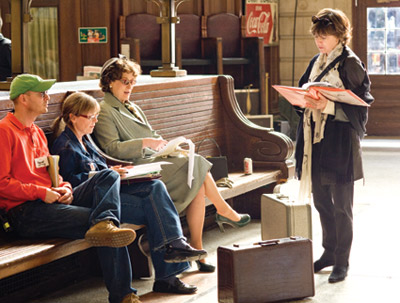 BY THE BOOK: Ephron directs Meryl Streep (2nd from right) as Julia Child in a scene
BY THE BOOK: Ephron directs Meryl Streep (2nd from right) as Julia Child in a scene
from Julie & Julia. "As movies go," she says, "it was about as good as it gets."
(Photo: Jonathan Wenk/Columbia)"Dying is easy," the actor Sir Donald Wolfit is reputed to have said with his last precious breaths on this earth; "comedy is hard." That gallant thespian's bon mot might go a ways toward explaining why the word "hard" pops up with such alarming frequency in the discourse of the director Nora Ephron, who has zero personal knowledge of dying but plenty of experience with comedy. On a snowy Manhattan afternoon, as we speak about the movies she has made—which include Sleepless in Seattle (1993), You've Got Mail (1998), and Bewitched (2005)—and how she made them, the concept of difficulty looms large.
For example: "Romantic comedies are very hard. They look as if they should be easy, but they're hard because there's nothing you can depend on. I mean, you don't have car chases or anything like that and, really, you don't have plot in the way we understand that term—we all know pretty much from the start what the end of the movie is going to be." And she's just getting warmed up: "Romantic comedies are hard to do, but so are all movies. Movies are so hard, and they're harder than ever because it's so hard to get them made now, and so hard to do anything remotely unconventional, because that scares people to death." (Which is, of course, easier than comedy.)
Despite the general hardness of things, Ephron has reasons to be cheerful. She has recently finished—"all done, everything, locked"—the at least remotely unconventional Julie & Julia, the seventh film she has directed. Meryl Streep plays the great, eccentric chef Julia Child and Amy Adams is a woman named Julie Powell, who sets herself the daunting task of actually preparing every recipe in Child's magnum opus, Mastering the Art of French Cooking. (The movie is scheduled to open in August.) Although the budget was on the low side for Ephron's taste, it sounds as if the making of Julie & Julia wasn't too arduous for her. "As movies go," she says, "it was about as good as it gets. Meryl is so remarkable in it, I cannot begin to tell you. And we had a week of shooting in Paris, and of course you can't just go there, you have to scout it—many, many trips," she laughs.
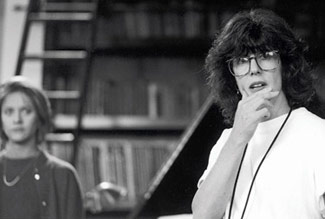 STOP, LOOK, LISTEN: Ephron figures out how to get the most out of her actors.
STOP, LOOK, LISTEN: Ephron figures out how to get the most out of her actors.
Sleepless in Seattle (with Meg Ryan). (Credits: Sony Pictures)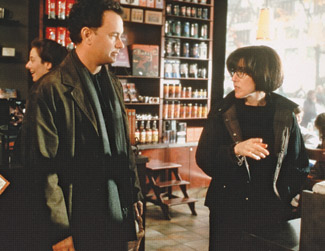 You've Got Mail (with Tom Hanks). (Credits: Warner Bros./Kobal)
You've Got Mail (with Tom Hanks). (Credits: Warner Bros./Kobal)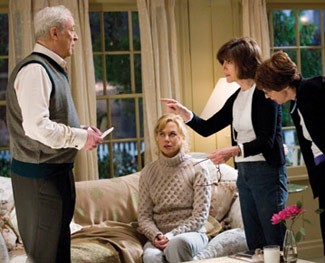 Bewitched (with Michael Caine and Nicole Kidman). (Credits: Columbia Pictures/Everett.)
Bewitched (with Michael Caine and Nicole Kidman). (Credits: Columbia Pictures/Everett.)The movie is not, she wants to emphasize, a romantic comedy of the sort she's known for: "I don't know what it is, but not that." What it has in common with all but one of the other films she's directed is that she's also the screenwriter. And although she speaks knowledgeably about the craft of filmmaking, she tends to see the technical skills she has acquired in the 17 years since directing her first movie, This Is My Life, in terms of writing.
Asked, for instance, about the distinctive way she uses music in her films—among the charms of Sleepless in Seattle is her cunning deployment of standards like "Bye Bye Blackbird"—she says, "I always thought about music when I was doing scripts, but I had no idea one of the things you get to do as a director is write the movie with music all over again after you're done with it. That's one of the most delicious parts of being the director."
On this topic, she becomes almost rhapsodic. "My editor, Richard Marks, and I sometimes just look at each other in amazement, over and over and over again, when that thing happens where the piece of music suddenly knits the scene together with the next one, or tells the audience a little bit more than they'd know without it."
In Julie & Julia, though, there weren't quite so many of those magical editing room moments. She says, "I felt I had to use more score versus songs than I normally do, because there's a lot of voiceover. Not that you can't necessarily use songs with voiceover, but it's a lot for the audience to be hearing simultaneously." She pauses a beat. "Also, we didn't really have the money to buy too many songs." There is, however, "a Charles Aznavour, of course, and an absolutely incredible Margaret Whiting version of 'Time After Time.'"
And when it comes to postproduction, she says, "I always feel like I'm rewriting the movie. I'll look at the assemblage and say to myself, 'How could I possibly have shot this much extra stuff? And what am I going to do when I cut this scene that I thought was absolutely essential and it doesn't work at all and it can't be in the movie, but three scenes later there's a reference to it and how am I going to fix that?'" She catches her breath. "That's the nightmare-slash-fun of the first cut, that you just basically have to rewrite the movie."
Ephron is the daughter of writers (Henry and Phoebe Ephron, who wrote the scripts for, among others, Desk Set) and the sister of another (Delia Ephron, with whom she has frequently collaborated). She is also married to writer Nicholas Pileggi, who wrote the screenplay for GoodFellas, based on his book Wiseguy. So it's probably inevitable that her approach to filmmaking is, well, writerly. It's a good deal less inevitable that she should also have mastered, as she has, the many different and difficult tasks included in the job description for a director of major motion pictures. Her choice to think of all these various skills metaphorically as "writing" doubtless helped facilitate the transition. But it wasn't easy. She wrote Silkwood (1983) and—from her own autobiographical novel—Heartburn (1986) for Mike Nichols, and then, in 1989, Rob Reiner's romantic comedy When Harry Met Sally, the hit that afforded her, at age 50, the opportunity to direct a film herself.
"I'd been fantastically lucky as a screenwriter, because Mike Nichols is someone who always wants the writer around, so I was able to watch him and also to watch Rob make When Harry Met Sally," she says. "So I actually thought I knew something. Of course I knew nothing. Nothing. I cannot begin to tell you. It's truly laughable to me now that I went into this completely fearlessly. It took me a long time to learn really important things like, don't write a scene that you have no idea how to direct, you know?"
There was also a bit of a learning curve involved in the art of working with the experienced and often opinionated technicians that make up a film crew. "I had a really hard time with my cameraman on my first movie," she says. Remembering a story Mike Nichols told her about his first day on the set of his first film, Who's Afraid of Virginia Woolf?—a story with the punch line, "I know what I'm going to tell and they don't,"—she realized that, ultimately, "being the director means that you're the one who knows best what the movie is about. That's at the root of every decision about where the camera's going to be. It's not whether it's a good shot or not, but whether it has anything to do with what the scene's about."
Her relationship with her cinematographers has gone much more smoothly since those early trials. She says, "You want a cinematographer—like John Lindley, who I've used a lot, and Stephen Goldblatt, who did Julie & Julia—that you can talk to. You have these long conversations about the look of the movie and you desperately hope that what you've said is going to in some way correspond to what they do. If your cinematographer likes a certain location better than one you like, that's interesting: What can we do there that we can't do here? That can be very useful."
One DP she loved working with is Sven Nykvist, who shot Mixed Nuts (1994) and Sleepless in Seattle. Talking about him, Ephron comes about as close as a smart, sophisticated Manhattanite can to bubbling with enthusiasm. "Are you kidding?" she exclaims. "Sven? He was a lovely man. He had no idea what anybody was saying in any scene, but he always knew what the scene was about. When he worked with Ingmar Bergman, he never had much equipment—he lit an entire movie with candles. So when we went into Tiffany's one day to shoot a little scene with Meg Ryan and Bill Pullman for Sleepless in Seattle, he just put in two 5K lights. That's all he did. Conrad Hall turned up that day, because he'd seen Sven through the window, and when he walked in and looked at those two lights, he started laughing, thinking about how long it would have taken anybody but Sven to do this."
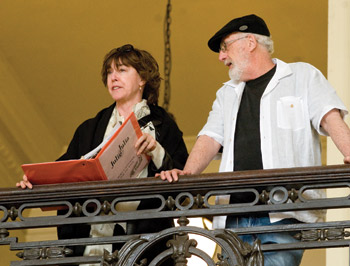 CITY OF LIGHTS: Ephron, shooting Julie & Julia in Paris with DP Stephen Goldblatt,
CITY OF LIGHTS: Ephron, shooting Julie & Julia in Paris with DP Stephen Goldblatt,
says, "You want a cinematographer who you can talk to about the look of the movie."
(Photo Credit: Jonathan Wenk/Columbia)Even before she begins working with a cinematographer, Ephron has already done quite a bit of the directorial activities that she likes to think of as "writing." Two weeks of rehearsals with the cast, for example, during which the script always changes "totally, totally." And storyboarding. "I storyboard extensively," she says. "For me, that's one of the rewrites you do, putting the story on paper as pictures and seeing what doesn't work. You can always see very clearly if a scene is too long when you storyboard it, I think."
And afterward, when the movie is shot and edited and mixed and printed, the process isn't necessarily over yet. "With comedies especially," she says, "you have to have previews. I mean, I don't make art films, and much as I would like to keep my movie in a room and show it to four friends at a time, you really have to go to The Valley with the National Research Group and see what you've got." If the audience's reactions indicate that something isn't working, "I can't say to the studio, 'I don't care that this doesn't play,' because you make a comedy for it to play."
Pressed for an example of a movie she had to alter significantly after a preview, she initially responds with horror—"Oh, don't, don't, don't make me go there"—and then relents. "After the first preview of Michael," her 1996 comedy in which John Travolta plays an impish angel, "we realized that we'd cut the movie wrong, that we had played too many scenes wide because we had an ensemble that I thought was very funny. But it was absolutely clear after the first screening that we couldn't stay with the master as much even though the master played nicely. We had to keep cutting to a close-up of Travolta or the movie wasn't going to work. The preview changed the movie."
The one aspect of the director's craft to which Ephron appears as yet unreconciled is the use of special effects, which she was naturally required to employ for Michael and for the paranormal comedy Bewitched. "Effects? I hate them," she splutters. "I really hate them. It's a nightmare, a complete nightmare. It's so painfully hard to get the simple things you need from these effects houses. It feels like you're trying to communicate with people who don't speak the same language you do, and the reason is they don't. It's endlessly, endlessly difficult and complicated."
She admits that on Julie & Julia a few simple effects came in handy in the Paris scenes, which are meant to show the City of Lights as it was in the 1940s and '50s: "We were able to make some of the buildings that were too sparkling clean look a little dirtier, as they were then." Seconds later, the frustration resurfaces: "But real effects, oh my God, they're horrible."
And right after that, Nora Ephron, director of comedies, turns a tad wistful. "My preference would be to do a movie with a small number of people sitting in rooms and talking," she says. "This is my dream." Now, that sounds hard.